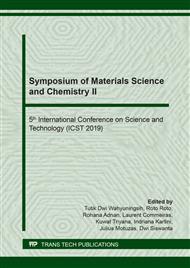p.406
p.412
p.418
p.424
p.430
p.441
p.448
p.454
p.459
The Implementation of Fast Fourier Transform and Coherence Function to Detect the Millimetric Hole on Strip Iron Plate
Abstract:
In this study, Fast Fourier Transform (FFT) was used in order to detect bore hole in a structure. FFT is a common method in digital signal processing (DSP) to characterize the frequency emitted by some structure. This method is widely used because of its simplicity. Computational time needed for FFT is relatively lower than another method. The use of FFT to analyze defect in structure is not commonly used since FFT has some weakness for example spatial frequency cannot be extracted to point out the defect location. In this paper, defect was designated as a hole in a strip iron plate with 20 mm in diameter. The strip iron plate was 1 meter long, 38 mm wide and 3 mm thick. This strip iron plate was clamped at one of its ends while the other side is left free. In order to produce vibration signal, impact hammer Bruel Kjaer Type 8202 was used with plastic tip to limit the vibration frequency in to the range of 0 - 1000 Hz. The trigger point was 30 mm from its free end. Three accelerometers were placed series in one line with the trigger point with 300 mm distance of each accelerometer. The position of the hole was varied in three different position. The first position was between trigger point and first accelerometer, between first and second accelerometer and between the second and third accelerometer. The raw signal obtained from the accelerometer was processed by using FFT to understand the mode shape changes in the strip iron plate due to the bore hole. Furthermore, the FFT result was analyzed as function of receiver position to determine the position of hole. The result shows that the frequency characters were different in each case and further analysis by using magnitude-squared coherence function need to be used in order to quantitatively find the difference between FFT result.
Info:
Periodical:
Pages:
430-437
Citation:
Online since:
April 2020
Authors:
Keywords:
Price:
Сopyright:
© 2020 Trans Tech Publications Ltd. All Rights Reserved
Share:
Citation:


